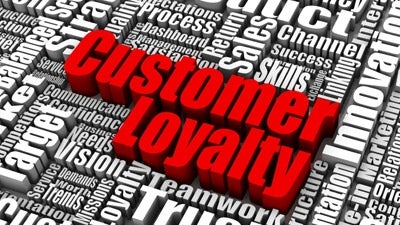Home > Run and Grow > Customer Service >
Moving from Customer Service to Customer Experience
By: Bill Hogg

Most of us already know that customer service is not good enough—it is no longer a differentiating factor. The brutal business reality is that three quarters of your customers would gladly do business with your competition—even if they were satisfied with the service experience.
We all know the difference between good and bad service, but in order to compete, you have to move beyond this and focus on the overall experience you create for your customers. Successful companies must shift their focus from providing satisfactory customer service to creating a memorable customer experience that builds loyalty.
Your customer relationships are your only sustainable competitive advantage for growth and profitability. So rather than focusing on a specific customer interaction, a true customer experience is focused on your relationship with a customer from the moment you engage them and over the duration of your relationship with that customer.
Build relationships that provide an emotional connection
Rather than focusing on the transactional aspect, companies will build long term relationships with customers if they focus on the emotional connection that customers seek. Every one of your customers has an emotional need that calls for attention.
This issue is not necessarily a product or service, but convenience, time sensitivity, or specific knowledge they require as part of the transaction with your company. Failure to connect emotionally will prevent you from creating that bond, and ultimately prevent you from making the sale.
Companies need to anticipate these opportunities by creating an experience that their customers desire by addressing the emotional connection as part of their interaction with customers.
Here are some thought starters:
- Put yourself in your customer’s shoes. What do they want beyond your products/services?
- Understand your customer’s needs. Provide an experience your customer would want if they could ask for anything?
- Anticipate future needs. What might they want but haven’t yet figured it out yet?
- What is your customer’s emotional need? Ask questions and pay attention to the conversations you have and look for their emotional touch point. If you satisfy their emotional need, you have created an experience that is memorable And, memorable experiences keep them coming back.
The 3 levels from customer service to customer experience
Identifying where you lie on the customer service to customer experience continuum is the first step. Once you understand your level of customer service, you need to develop action steps and look internally for how you can not only improve in terms of providing a great customer service, but what you can do to take things to the next level.
Let’s look at the 3 levels and what you can do to move your company from customer service to customer experience.
1. Satisfying customers (this is just good customer service)
This is where most companies reside. They are focused on a single customer interaction. These companies are focused on short term gains and have a transaction by transaction approach to service. They either do not see the importance or do not want to put the effort into developing long term relationships with customers.
While satisfying customers and providing good customer service is a necessary component of customer experience, companies need to come to the realization that satisfying customers will only get them so far. Customer satisfaction with a single service experience simply provides the opportunity to serve that customer one more time—and limits their ability to grow and create loyal repeat business.
What needs to be done to take your service capabilities to the next level?
Start thinking about the long term ramifications of taking a transactional approach to service. How much of your sales are based on repeat business? Consider these action steps:
- Start by taking a look at your current service experience and look for areas to improve it
- Crunch the numbers! Are customers coming back on a regular basis? What is the long term value of a customer and what is the cost associated with replacing a lost customer with a new customer.
- Attempt to answer “why?” Why are your customers coming back and why are they not coming back? Why are they choosing you over your competitors?
- Talk to your employees. Your frontline workers are the ones who interact and make an impression on your customers
- Talk to your customers. Ask them to take a customer satisfaction survey. But make sure it is focused on how to improve—not simply are you satisfied—otherwise you won’t discover the insights that will help you rise to the next level.
If you want to create a loyal base of customers, you have to satisfy them first. Master customer satisfaction, and then work on building a loyal base.
2. From satisfying customers to loyal customers
When companies move beyond satisfaction and focus on developing a loyal base of customers, they recognize that loyal customers generate repeat and sustainable business. Loyal customers move you from having short term transactional relationships to long term repeat customers.
What are you doing to build loyal customers?
- Do you understand and provide an experience your customers would want?
- Are you creating an experience that meets their emotional needs?
- Do you incent customers to come back?
- How do you reward your loyal customers?
What actionable steps can be taken to build a loyal customer base?
- Implement a customer loyalty program if you do not already have one. People love to be rewarded. How do you recognized and acknowledge repeat customer so they feel special and linked to your organization? Consider a points or rewards system for frequent purchases.
- Identify specific actions you can take to exceed expectations with every interaction — not just meet them. Build these into your intentional experience
- Get to know customers personally. Learn more than just their names—learn about their needs that your company helps address and how you can help them be more successful.
- Make your customer’s opinion matter. Take their feedback seriously, listen attentively to their concerns and accommodate their needs.
- Regularly track your repeat business. Are customers coming back? Understand what the key elements are that drive repeat business and build on them.
- Tell people about your great customer experience. Make it part of your advertising and marketing campaign. When you current customers verify the messages you are conveying it will entice new customers visit.
3. From loyal customers to brand advocates
A loyal customer base will ensure that the same customers keep coming back. Customer experiences that create an exceptional emotional return for your customers will turn them into brand advocates. And, this is where your business will kick it into high gear and you will start to experience a higher volume of new and passive sources of revenue.
Great customer experiences make customers feel like they have received something exceptional. This positive experience you deliver creates an imbalance that disturbs the natural sense of reciprocity. When this happens, it creates brand advocates. They want to reciprocate by promoting your business—through word of mouth, social media, online reviews, and other traditional means—to balance the scales of reciprocity
What are you doing to create brand advocates out of your customers?
- Are you focusing on your relationship first and transaction second?
- What are you doing to engage customers?
- Are you listening to your customer’s real concerns?
- What are you doing to offer outside the box experiences?
- If you want brand advocates you have to give them something to talk about.
Consider taking these actions to create an army of advocates:
- Look for ways to create value. The only time you interact with them shouldn’t only be when they are doing business with you. Send them useful and relevant information periodically. Email lists, newsletter, and special offers keep you in your customers mind.
- Create a 5 year vision for your customer relationships. How does that relationship evolve from their perspective — not yours? What can you do to become a valued strategic partner in their business success versus simply a supplier of goods or services?
- Get social! Engage with your customers online and develop an open dialogue with them. Social platforms give your customers to opportunity to interact directly with you and become an insider versus a customer. It also allows them to share your company with other users—the electronic version of word of mouth promotion.
Great customer service just does not cut it anymore. Companies that truly want to be in a position to grow need to focus on growing their relationships with customers and providing an experience that will get your customers talking and keep them coming back.
This article was originally published by Bill Hogg
Published: May 31, 2013
4018 Views
4018 Views












